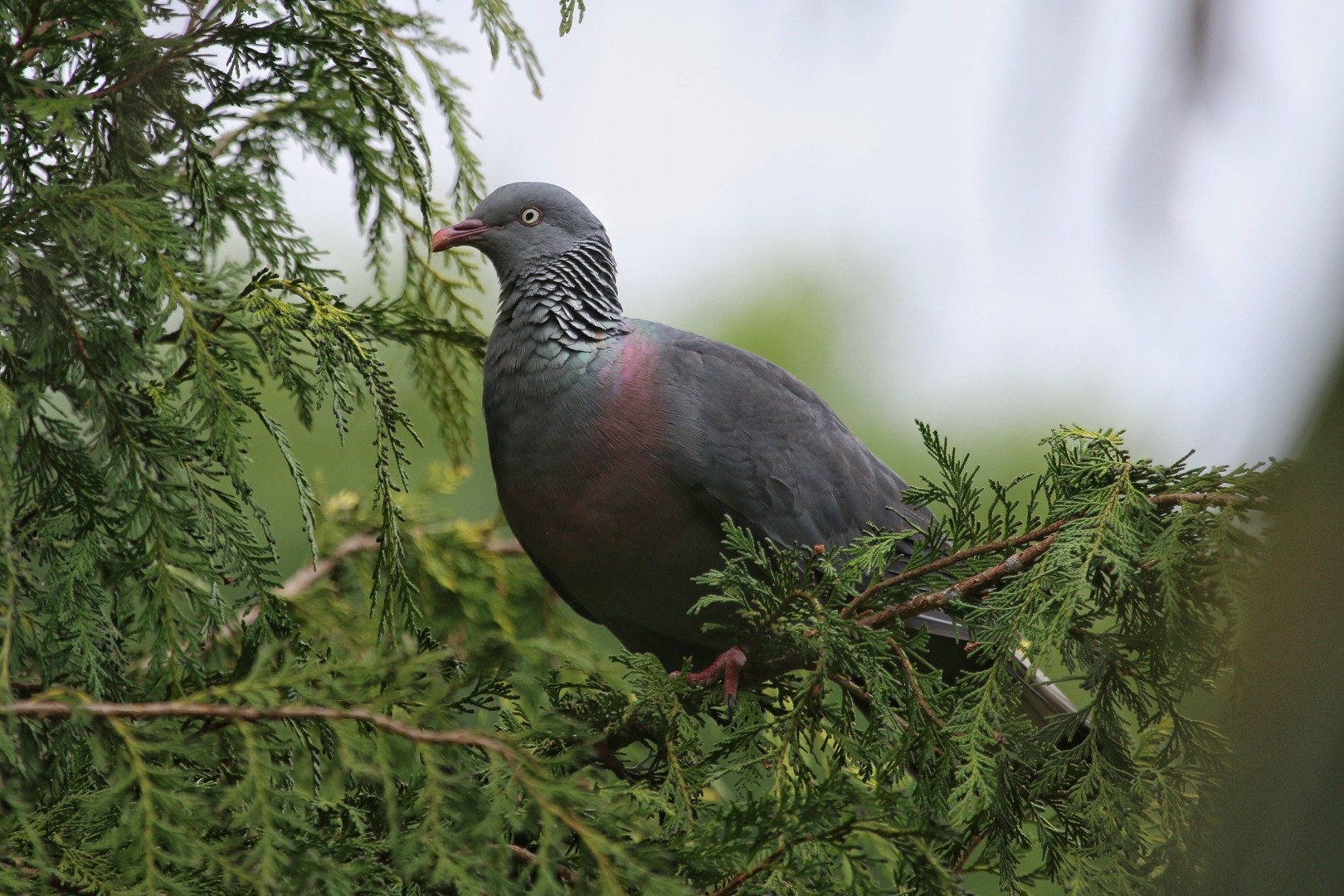Trocaz Pigeon
A species of Old World Pigeons, Also known as Long-toed Pigeon Scientific name : Columba trocaz Genus : Old World Pigeons
Trocaz Pigeon, A species of Old World Pigeons
Also known as:
Long-toed Pigeon
Botanical name: Columba trocaz
Genus: Old World Pigeons
Content
Description General Info
Description
The trocaz pigeon is a rather plain, dark grey bird 40–45 cm (15.7–17.7 in) long with a 68–74 cm (26.8–29.1 in) wingspan. The upper back has a violet sheen, becoming green on the back of the neck, and the neck sides are patterned with silver-white. The tail is blackish with a wide, pale grey band, and the flight feathers are mainly black. The upper breast is pinkish, the eye is yellow, the bill has a yellow tip and a reddish-purple base, and the legs are red. The sexes are similar in appearance, but the juvenile has generally browner plumage, with limited or no development of the silvery neck patch. Its closed wings have a scaly appearance due to pale buff feather edges. The trocaz pigeon's voice is weaker and deeper than that of common wood pigeon, typically consisting of six syllables with the middle pair of notes extended and stressed: uh-uh hrooh-hrooh ho-ho. When flying, it appears heavy and large-tailed, although its flight is rapid and direct. The common wood pigeon had a poorly defined Madeiran subspecies, Columba palumbus maderensis. This was paler than the trocaz pigeon and had white wing patches and a more extensive green iridescence on the nape, but it became extinct before 1924. Bolle's pigeon is more similar in appearance to the trocaz pigeon, although it lacks the whitish neck patch and has a more extensively pink breast. However, that species is endemic to the Canary Islands, so there is no range overlap. The only other pigeon currently present on Madeira is the feral pigeon; this is slimmer, has more pointed wings and a much smaller tail. It often has dark wing markings, and a lighter flight. 
Size
40 cm
Nest Placement
Tree
Feeding Habits
Trocaz Pigeon consumes a primarily herbivorous diet, with 60% fruit, predominantly from Til, Azores Laurel, and Persea indica, and lesser amounts of leaves and flowers. They forage seasonally, eating more leaves in spring/summer and fruit in autumn/winter. Trocaz Pigeon adapts to food scarcity by feeding on crops like cabbage, especially when native fruits are sparse. Despite opportunistic feeding in agricultural lands during winter, they mostly forage in forests. Unique digestive traits include intact seed pass-through, except for Azores Laurel seeds. Trocaz Pigeon also faces competition for food with rats.
Habitat
The trocaz Pigeon is typically found in high forest zones characterized by frequent cloud cover. Its preferred environment consists mainly of forests with tall laurel trees and thick undergrowth dominated by dense tree heather. These habitats provide the necessary conditions for its survival, with a canopy that supports its nesting and foraging activities.
Dite type
Granivorous
General Info
Feeding Habits
Bird food type
Distribution Area
The trocaz pigeon is endemic to the mountainous subtropical Atlantic main island of Madeira, although it formerly also bred on the neighbouring Porto Santo Island. It mainly occurs on the northern slopes of the mountains, but smaller numbers are found in the south where suitable patches of laurel forest remain. The natural habitat is tall laurisilva forest or dense tree heaths which are cloud-covered for much of the year. The forests consist mainly of Azores Laurel, Oreodaphne foetens, Til, Madeira Mahogany, Canary Laurel, Faya, Lily of the Valley Tree and the Picconia. The trocaz pigeon prefers primary forests, but secondary growth is used for feeding, and agricultural land is also visited, especially at times of fruit shortage. Most of the pigeons are found below 1,000 m (3,300 ft), and their prime environment appears to be steep ravine-indented slopes along artificial watercourses, with the occasional large dead laurel tree and much tree heath. This species is highly mobile between different areas at different times of year. 
Species Status
The trocaz pigeon formerly bred on both the main island of Madeira and nearby Porto Santo Island. It was very abundant when the islands were first colonised by humans, but was extirpated on Porto Santo, and by 1986 had declined to about 2,700 birds. Hunting was banned in that year, and there are now between 7,500 and 10,000 individuals in approximately 160 square kilometres (62 sq mi) of suitable habitat. The losses on the two islands, the only inhabited ones in the archipelago, were largely the result of deforestation for wood and to create agricultural and grazing land. The exclusion of livestock from the native forest allows the forest to regenerate and create more suitable habitat. Some illegal hunting and poisoning continues because of the damage this pigeon can do to crops, and the government allowed a cull in 2004. Perhaps the main limiting factor on the rate at which the pigeon increases its numbers is predation by introduced black rats on its eggs and young. The Parque Natural da Madeira national park has a management plan for the trocaz pigeon, and it is hoped that an education campaign and the promotion of bird scarers may reduce persecution. Its increasing population means that it is now classed as Least Concern on the IUCN Red List, an improvement on its Threatened status in 1988. This species is protected under the European Union Birds Directive, and the laurel forests under the Habitats Directive. 
Scientific Classification
Phylum
Chordates Class
Birds Order
Pigeons and doves Family
Dove Genus
Old World Pigeons Species
Trocaz Pigeon 